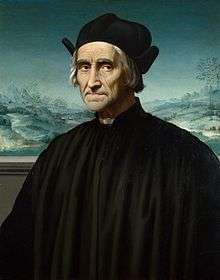Girolamo Benivieni
Girolamo Benivieni (Italian: [dʒiˈrɔːlamo beniˈvjɛːni]; 6 February 1453 – August 1542)[1] was a Florentine poet[2] and a musician.[1] His father was a notary in Florence.[3] He suffered from poor health most of his life, which prevented him from taking a more stable job.[4] He was a leading member of the Medicean Academy, a society devoted to literary study.[2] He was a friend of Giovanni Pico della Mirandola (1463–1494), whom he met for the first time in 1479;[5] it was Pico della Mirandola who encouraged him to study Neoplatonism.[4] In the late 1480s, he and Pico della Mirandola became students of Dominican friar Girolamo Savonarola (1452–1498).[6] In 1496, he translated the teachings of Savonarola from Italian to Latin.[6] After he began following Savonarola, he rejected his earlier poetry and attempted to write more spiritually.[6] He participated in Savonarola's Bonfire of the Vanities, and documented the destruction of art worth "several thousand ducats".[7]
Girolamo Benivieni | |
|---|---|
 Portrait of Benivieni at the National Gallery in London, painted between 1510 and 1520, and attributed to Ridolfo Ghirlandaio | |
| Born | 6 February 1453 |
| Died | August 1542 |
| Occupation | Poet |
He was supported in his writing by noblewoman Lucrezia de' Medici (1470–1553).[2] They were both interested in the works of poet Dante Alighieri (1265–1321).[2] In 1506, Benivieni published an edition of the Divine Comedy with maps by Antonio Manetti (1423–1497) and commentary by Manetti and Benivieni.[8] In March 1515 Benivieni drafted a letter to be sent from Lucrezia to her brother, Pope Leo X (s. 1513–21), seeking his assistance in bringing the body of Dante back to Florence.[2] On 20 October 1519, Benivieni signed a Medicean Academy petition to Pope Leo, again requesting the return of Dante from Ravenna.[9] Benivieni also used his connection with Lucrezia to advance his ideas on church reform with her brother, and later with her cousin, Pope Clement VII (s. 1523–34).[2] In 1530, he wrote a letter to Pope Clement in defense of Savonarola, seeking to have his reputation restored within the church.[10] He is buried together with Giovanni Pico della Mirandola at San Marco, Florence, Italy.
References
- Cummings 2004, p. 190.
- Tomas 2003, p. 95.
- Gardner 1914, p. xix.
- Gardner 1914, p. xxiv.
- Gardner 1914, pp. xvi–xvii.
- Baldassarri & Saiber 2000, p. 271.
- Villari 1969, p. 138.
- Heilbron 2010, p. 28.
- Cummings 2004, pp. 79–80.
- Gardner 1914, pp. xxiv–xxv.
Sources
- Baldassarri, Stefano Ugo; Saiber, Arielle (2000). Images of Quattrocento Florence: Selected Writings in Literature, History and Art. Yale University Press. ISBN 9780300080520. Retrieved 11 Jan 2016.CS1 maint: ref=harv (link)
- Cummings, Anthony M. (2004). "The Maecenas and the Madrigalist: Patrons, Patronage, and the Origins of the Italian Madrigal". Memoirs of the American Philosophical Society. American Philosophical Society. 253. ISBN 9780871692535.CS1 maint: ref=harv (link)
- Mirandola, Giovanni Pico della; Benivieni, Girolamo (1914). Gardner, Edmund Garratt (ed.). A Platonick Discourse Upon Love. Translated by Stanley, Thomas. Merrymount Press. Retrieved 11 Jan 2016.CS1 maint: ref=harv (link)
- Heilbron, John (2010). Galileo. Oxford: Oxford University Press. ISBN 9780199583522.CS1 maint: ref=harv (link)
- Tomas, Natalie R. (2003). The Medici Women: Gender and Power in Renaissance Florence. Aldershot: Ashgate. ISBN 0754607771.CS1 maint: ref=harv (link)
- Villari, Pasquale (1969). Life and Times of Girolamo Savonarola. 2. Translated by Villari, Linda. New York: Haskell House Publishers, Ltd. ISBN 08383-0174-6.CS1 maint: ref=harv (link)
External links
- "Portrait of Girolamo Benivieni". The National Gallery. Retrieved 11 Jan 2016.CS1 maint: ref=harv (link)